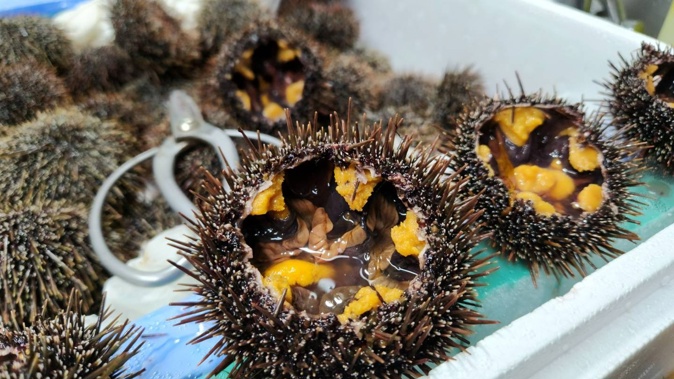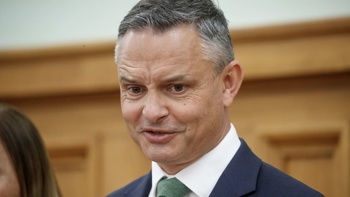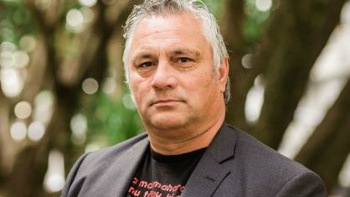
Working to enhance the size of the roe from malnourished kina while also supporting the restoration of kelp forests and marine ecosystems is the goal of a new project involving Ngāti Porou fisheries.
The 18-month Kinanomics project, led by natural resource sector project developer Johnny Wright of EnviroStrat, in collaboration with Ngāti Porou Seafoods and international restorative aquaculture company Urchinomics, seeks to validate the viability of enhancing wild-caught kina in land-based aquaculture systems to produce a much sought-after seafood delicacy.
There is no shortage of wild kina to harvest, with areas of New Zealand’s kelp forests overtaken by exploding populations of kina which have grazed the kelp down to bare rock, turning the seafloor into “barrens”.
Kina are voracious herbivores and consume kelp and seaweeds that are commonly found along our rocky coastlines.
/cloudfront-ap-southeast-2.images.arcpublishing.com/nzme/MD3CAZTXLRDDHEWJXMYM3IDYCU.jpg)
Kina from the Kinanomics project have been taste-tested by food critics and those who enjoy the food product. Photo / Johnny Wright
Kina are recognised as the key driver in the decline of kelp forests in some areas and have contributed to the loss of critical ecosystem services seaweed communities provide, such as habitats for fish, nutrient sponges and carbon sequestration. Once the kelp is gone, the kina often stay.
EnviroStrat senior environmental consultant and project lead, Johnny Wright, said the project was based on the principle of utilising barren urchins.
Barrens can happen really quickly, which is something Wright thinks not many people are aware of.
“It is a bit of a problem. Once a barren is created, there is nothing for the urchins to eat,” Wright said.
The size of the roe shrinks to a point where it’s not commercially viable and is no good for kai as it is too small.
Kina roe is a traditional food of Māori and a delicacy for many other people.
“When they are left in the barren, they don’t die. They are resilient little fellas — they sit there and cruise around to new algae and eat it, which maintains the barren.”
One solution for the barrens removing the urchins. One way is culling them, but that is time-consuming, expensive and also culturally inappropriate to some as they are a taonga species.
An aspect they are testing is enhancing the size of the roe by taking the urchins from barrens and putting them into a controlled system.
In this case, it’s a land-based aquaculture system, feeding the urchins either a formulated algae feed like a dried pellet, or kelp, just to give them enough food and nutrients for their roe to expand to a harvestable size.
“That’s what we are doing with Kinanomics. We are testing whether we can enhance barren urchins that are really skinny to a harvestable size over a short period of time. I’m talking about 10-12 weeks from a 2 per cent yield to a 15 per cent yield, which is a huge increase in roe size over a short amount of time,” Wright said.
/cloudfront-ap-southeast-2.images.arcpublishing.com/nzme/NM3DASQ7UJBTNE6N347WLWHNWE.jpg)
Kina from barren areas in the ocean are removed and taken to controlled aquaculture equipment at Niwa in Wellington to manage the growth of the urchins. Photo / Yann Gublin
The $2.2 million project is being supported with nearly $1m in investment from the Government’s Sustainable Food and Fibre Futures fund, administered by the Ministry for Primary Industries. Additional investment has come from EnviroStrat, Ngāti Porou and other funders.
Ngāti Porou Seafoods & Fisheries is one of only two iwi businesses in Aotearoa New Zealand participating in every stage of production, from the ocean to the plate. They will work with EnviroStrat and Urchinomics to develop the investment case for future scale-up. Ngāti Porou Seafoods will provide a quota for the pilot and will leverage the already strong market links it has developed through its fishery exports over many years.
The business case is about looking to export the product into East Asian markets as there is a potential for kina to be sold there.
“In New Zealand, pretty much all the wild-caught kina is sold domestically. We want to explore the option of getting it into those East Asian markets, where there is a strong demand.
“A main part of this is the environmental impacts; the whole point is to extract barren urchins, which removes a huge barrier for kelp to grow back in the area. We want to understand what we have to do in terms of the harvesting process and what the most effective way to pull the urchins out is to get the best kelp recovery we can.
“We are working with scientists and commercial fishers to understand what the protocol looks like. Along with post-harvesting monitoring, we want to prove that when we remove the urchin, kelp can return. We need a monitoring procedure to show that this mahi is getting the environmental return we say it does,” Wright said.
“The series of trials to see how the enhancement goes gets me most excited as I have a background in aquaculture and marine biology. We are working with Niwa in Wellington. They have equipment the urchins go in. They have experienced technicians and scientists, which is really great.
“So far, everything is going really well. We are getting positive results from the earlier enhancements we have done.”
They had a taste-testing panel in May last year which included participants from East Asia as well as food critics, an iwi Māori representative and a commercial fisherman.
There was a clear preference for the enhanced product over the kelp-fed product.
Josiah Cook, chief commercial officer of Nati Growth, said Ngāti Porou Seafoods & Fisheries are a subsidiary of Nati Growth Limited, responsible for managing the financial asset base of Ngāti Porou iwi.
“We’re involved with this project to understand what potential opportunities could come from this initiative for the people of Ngāti Porou — opportunities for kai, jobs and sustainable practices. We have investments into Seafoods & Fisheries’ interests, which include the local fresh fish shop, Real Fresh at 49 The Esplanade, Gisborne, and a fresh fish truck that travels to Ruatōria on a weekly basis.
“Being involved with opportunities like this allows us to provide direction and help influence practices and well-rounded considerations, taking into account economic, environmental, social and cultural factors.”
The project aims to be completed by the middle of 2024.
- Gisborne Herald Kaupapa reporter Matai O'Connor
Take your Radio, Podcasts and Music with you









